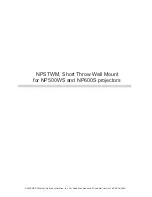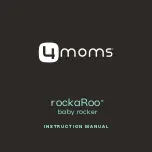
edge first
(Fig. 15)
. Avoid using loose fitting staples or inserting
them too close to the edge (less than 5/16", 8mm).
4.0 Maintenance
4.1 Fold Roller Removal and Cleaning
During normal operation, the fold rollers will become contami-
nated with paper dust, ink, copy toner and other performance-
inhibiting materials. At some point this will cause problems such
as wrinkling or marking the paper and even miss-folds or paper
jams. At this time, cleaning the rollers will be necessary. Follow
these steps to remove the roller assembly:
1. Disconnect the power cord from the outlet.
2. Remove (6) Phillips pan head screws from each of the side covers. Remove the side covers by
leaning them out at the top and sliding outward at the
bottom. Be careful with the switch wires on the right
cover.
3. Remove the drive belt by loosening
(do not remove)
the four
nuts on the motor and sliding the motor to the left. Slip the
belt off the top edge of the large pulley, then the motor pulley.
Do not over tighten the belt tension during re-installation.
4. Remove the four thumbscrews securing the 1st and 2nd upper
fold tables. Move the 2nd fold paper stop out to its longest
position to ease the removal of the 2nd table
(Fig. 16)
.
5. Pull the upper fold tables straight out a few inches to dis-
engage the bearing blocks. The upper tables can then be
lifted out of the way.
6.
Lower the feed table by pulling the feed table legs away from the folder and letting the feed table down.
(Fig. 17)
.
7. Remove the top cover assembly via the four Phillips flat head screws. Be careful not to damage the
exposed paper pusher spring or retarder during handling.
8. Remove (2) Phillips pan head screws from the bearing blocks. Grasp each bearing block at the top edge
and lift it straight up from the machine
Fig. 18)
.
9. Clean the exposed rollers by spraying Martin Yale Roller Cleaner
and Rejuvenator onto a clean cloth and wiping until all contami-
nates are removed. Turn the rollers with the large pulley to get all
the roller surfaces
(Fig. 19)
. Alcohol or a mild soap and water solu-
tion may also be used. Avoid getting cleaning solutions into the
bearing surfaces. If the fold rollers become glazed or shiny, it may
be necessary to return them to a dull luster by using a lightly abra-
sive non-metallic scouring pad.
Never use metal pads such as
steel wool or sand paper, as the shavings or grit will damage
the roller and bearing surfaces.
Fig. 15
Always feed the
stapled set in
with the stapled
edge first and
parallel to the
fold rollers
Fig. 16
Fig. 18
Fig. 17
Fig. 19
(6)
Lower feed
table before
removing
bearing blocks


























